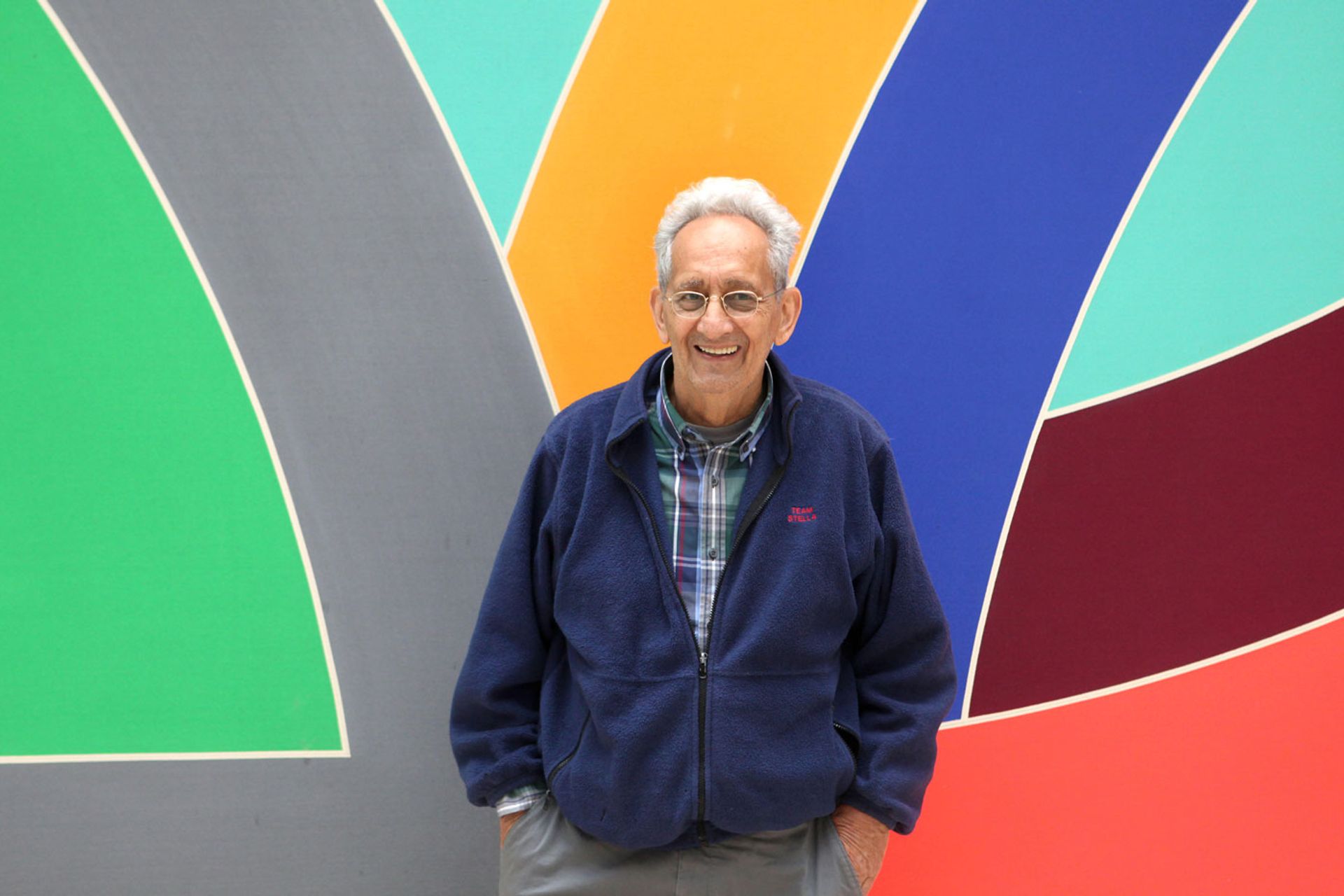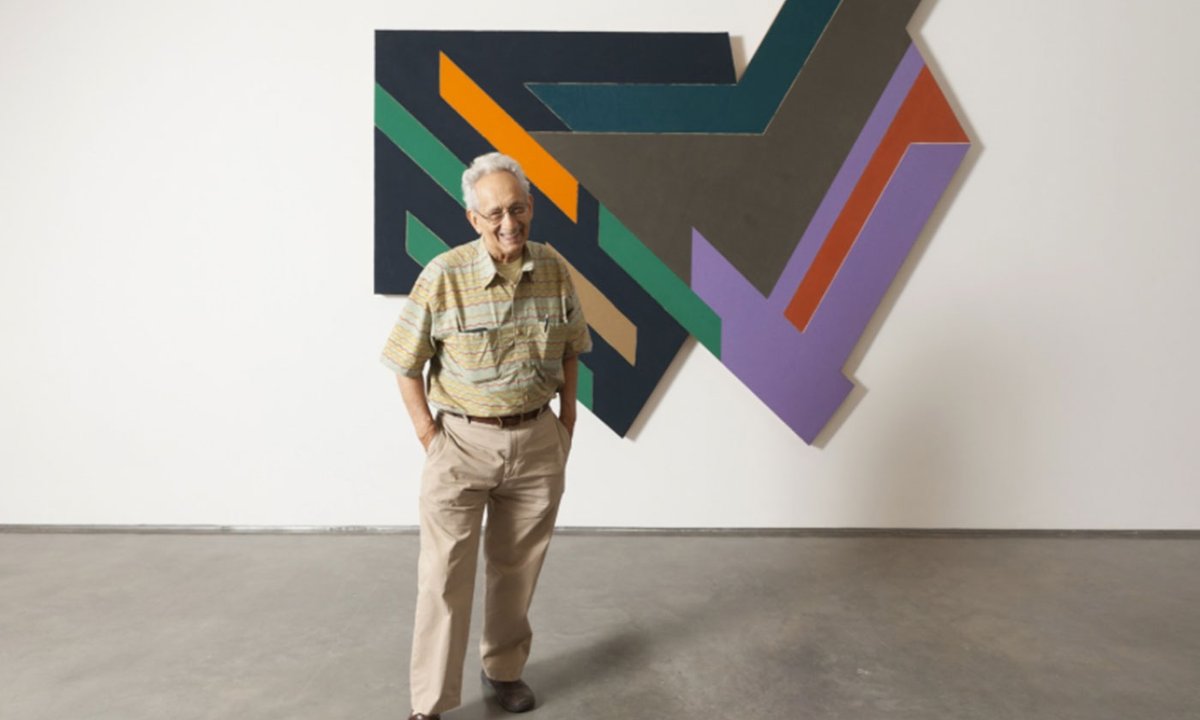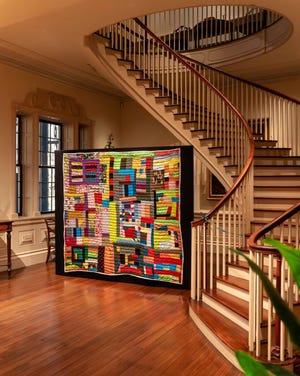Frank Stella, a towering figure in abstract art for the past 65 years, has died, aged 87. His death on 4 May, at home in New York City, was announced by Marianne Boesky Gallery, which has represented Stella since 2014.
The gallery paid tribute to how Stella’s “extraordinary, perpetually evolving oeuvre investigated the formal and narrative possibilities of geometry and colour and the boundaries between painting and objecthood”. “It has been a great honour to work with Frank for this past decade,” Marianne Boesky said. “His is a remarkable legacy.”
Frank Stella made an instant name in 1959 with his austere striped monochrome Black Paintings—and received his first one-man show at Leo Castelli Gallery in 1960—before graduating to metallic hues and then bright colours, in a wide range of geometrical configurations. In his first decade of work in New York City, Stella had his work featured in a series of landmark exhibitions at the city’s leading institutions including Sixteen Americans (1959) at the Museum of Modern Art, Geometric Abstraction (1962) at the Whitney Museum of American Art, The Shaped Canvas (1964) and Systemic Painting (1966) at the Solomon T Guggenheim Museum, and the Structure of Color at the Whitney in 1971.
Stella’s Protractor series, named after the geometry tool of the same name and launched at Leo Castelli in 1967, cemented his influence on abstract art in the 1960s and 1970s. Looking back at those years in 1999, when he had a sculpture show at Bernard Jacobson in London, Stella said “I have outgrown or outlived the dealers [of the 1960s]. Larry Rubin is retired; Leo Castelli is gone. I actually grew up in a different generation and they are all gone now. My world is past and gone. I’m out there hassling to keep going, but I do not really fit into the hard world.”

Frank Stella poses with one of his works at the Kunstmuseum in Wolfsburg, Germany, during his 2012 restrospective Photograph: Matthias Leitze/Alamy Stock Photo
In the 1970s he turned to making relief paintings which grew gradually more complex. “The relief paintings forced me to go out and get involved in the real world,” he told The Art Newspaper in 1999. “I had to go out to buy felt and plywood and honeycomb aluminium and things like that. I started to bring things into my work, rather than work with things in the controlled conditions of the studio. Picasso went out quite a bit, but, by our standards, one would say that he did not so much go out as he went far with his materials.”
I feel that one of the nice things about outgrowing everything is that it’s up to everybody else now
Frank Stella
Stella graduated into working on large-scale sculpture and architecture, collaborating with architects including Richard Meier and Santiago Calatrava. In 1983-84 he gave the Charles Eliot Norton lectures at Harvard University, called Working space (published under the same title by Harvard in 1985) in which he commended baroque and other painting for its poetic, as well as constructive, use of space and volume.
‘What you see is what you see’
Stella was famously direct in discussing his art. His much-referenced remark “what you see is what you see” was offered to the art historian Bruce Glaser in 1964 for the sake of clarity about his early Minimalist work. “That doesn’t leave too much afterwards, does it?” asked Glaser. “I don’t know what else there is,” Stella replied. Speaking to The Art Newspaper half a century later, he remarked “I’ve said it many times: abstraction can be a lot of things. It can, in a sense, tell a story, even if in the end it’s a pictorial story.”
Speaking to Norbert Lynton for The Art Newspaper in 1999, Stella reflected on public perception of his work in the first 40 years of his career: “People say, ‘Why do you change?’ I do not change all that much. The changes really come from two things: one, being a little bit dissatisfied; the other being a little bit hopeful, looking for something else. Everyone wants you “to find yourself”, to have a style. That is great when it happens, but, by and large, artists want to keep looking.”
A champion of new technologies
Stella was a noted pioneer of new technologies and worked with computer-aided design (CAD) and 3D printing from the late 1980s. In the mid-2000s, The Art Newspaper reported, Stella used a 3-D printer to produce metal and resin segments for his polychrome sculpture series Scarlatti Kirkpatrick. The technology, Ron Labaco, a curator at the Museum of Art and Design in New York, told Julia Halperin for The Art Newspaper, gave Stella “an opportunity to project work out from the wall in a way that would have been difficult, and too heavy, using traditional means”. Labaco featured Stella’s work in an exhibition devoted to computer-enabled pieces, Out of Hand: Materialising the Postdigital (2013-14).
When Stella minted his first NFT (non-fungible token), for his work Geometries, in 2022, he collaborated with the Artists Rights Society (ARS)—founded in 1987, to represent artist rights through copyright, licensing, and monitoring visual artists in the United States—a connection reflecting Stella’s involvement with and support of the ARS. “We sold out all 2,100 tokens,” Katarina Feder, director of business development at ARS, told The Art Newspaper, “and, importantly, brought in resale royalties for secondary sales, something that Frank has been championing for decades.”
The ARS, through its digital arm ARSNL, reached out to NFT collectors by publishing a process video and curatorial statement by the art analytics expert Jason Bailey. “These digital collectors fell in love with Frank and his work,” Feder said, “and many of them created their own derivatives, something that Frank allowed for. We showed some of these to Frank and he loved them.” The NFT drop appealed to Stella, as he told the NFT magazine Right Click Save, because “In a very abstract way [NFTs] seem like a possible way to solve some of the issues that come from ever-increasing reproducibility caused by technological progress in imaging and fabrication. But more concretely, they may be a way for artists to seize the resale rights that I want us to have”.
Stella’s open approach to the NFT drop, in which the artist proposed that collectors have the right to create derivatives and the right to 3D print the artwork, helped solidify the artist’s legacy as a painter’s painter. As Gretchen Andrew noted in her Art Decoded column for The Art Newspaper: “As much as Stella has cared for material, physical form and surface, he has cared for the rights of his fellow artists,” Andrew wrote. “For decades he has been lecturing and lobbying for the cause of resale rights.”
By the time of his 2015 retrospective at the Whitney, Stella no longer carried the burden of Minimalism that he had assumed with his Black Paintings. “I feel that one of the nice things about outgrowing everything is that it’s up to everybody else now,” he told The Art Newspaper.
Frank Philip Stella, born Malden, Massachusetts 21 May 1936; married 1961 Barbara Rose (died 2020; one son, one daughter; marriage dissolved 1969); partner of Shirley De Lemos Wyse (one daughter); married secondly Harriet E. McGurk (two sons); died New York City 4 May 2024.
Read more of Frank Stella in his own words from The Art Newspaper archive.
- This is a developing story.







